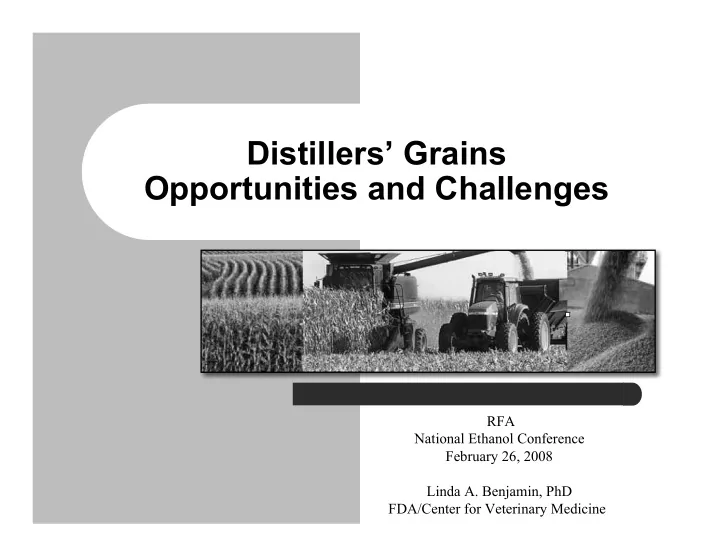

Distillers’ Grains Opportunities and Challenges RFA National Ethanol Conference February 26, 2008 Linda A. Benjamin, PhD FDA/Center for Veterinary Medicine
Center for Veterinary Medicine Approves safe food additives for animal feed, including pet food Approves drugs for animals including those used in animal feed Monitors and establishes limits for feed contaminants Ensures animal feed, including pet food, are labeled correctly A safe animal feed supply helps ensure healthy animals and people
Federal Food, Drug and Cosmetic Act The United States Federal Food, Drug and Cosmetic Act (FFDCA) is a set of laws passed by Congress in 1938 giving authority to the Food and Drug Administration (FDA) to oversee the safety of food , drugs and cosmetics.
FFDCA Definitions The FFDCA defines “food” as (1) an article used for food or drink for man or other animals, (2) chewing gum, and (3) articles used for components of any such article. The FFDCA defines “food additive” as any substance the intended use of which results or may reasonably be expected to result, directly or indirectly, in its becoming a component or otherwise affecting the characteristics of any food (including any substance intended for use in producing, manufacturing, packing, processing, preparing, treating, packaging, transporting or holding food…… The FFDCA defines “animal feed” as an article which is intended for use for food for animals other than man and which is intended for use as a substantial source of nutrients in the diet of the animal, and is not limited to a mixture intended to be the sole ration of the animal.
Food/Feed Ingredient Food Food additives Color additives GRAS substances Prior-sanctioned substances Regulatory discretion substances, i.e. AAFCO feed ingredients
FFDCA Requirements … The FFDCA sets forth requirements for foods in the Sections 402 and 403. Failure to meet these requirements can result in a product being deemed “adulterated” or “misbranded”. Although FDA has the responsibility for regulating the use of animal food/feed products, the ultimate responsibility for the production of safe and effective animal food/feed products lies with the manufacturers and distributors of the products.
FDA Letter to Feed and Feed Ingredient Manufacturers May 16, 2007 The U.S. Food and Drug Administration (FDA) is taking this opportunity to remind feed and feed ingredient manufacturers of their legal responsibility to ensure that every ingredient used in their products is safe for its intended use, whether the product is meant to be used to feed animals intended for human consumption or non-food animals such as pets. Manufacturers are responsible for taking their own measures to ensure the safety of their products. Manufacturers should not wait for possible FDA testing of their materials as manufacturers bear the responsibility of ensuring only safe products are put on the market.
Are You a Feed or Feed Ingredient Manufacturer?
Are You a Feed or Feed Ingredient Manufacturer? Yes
What Does This Mean…..
Regulatory Requirements Distillers’ Grains Genetically Modified Plants - Biotechnology Notification File Manufacturing (Process) Ingredients - Approved Food Additive, GRAS, AAFCO Feed Ingredient Definition, or Regulatory Discretion Fermentation Microorganisms and Enzymes – Processing Aids – Antibiotic/ Antimicrobial Drugs – Post-Processing Aids – Novel Co-Products - Approved Food Additive, GRAS, or AAFCO Feed Ingredient Definition Contaminants - The FDA Compliance Program Guidance Manual contains information on the following: Pesticides/Industrial Chemicals; Elements; Mycotoxins; Microbes; and Dioxins
Nationwide Survey of Distillers’ Grains for Antibiotic Residues Multi-analyte residue method developed by CVM’s Office of Research To collect samples of distiller by-products for shipment to OR to determine the prevalence of antibiotic residues 60 samples 30 Central (4-CHI; 1-BAL: 2-CIN; 4-DET; 19-MIN) – 25 Southwest (1-DAL; 2-DEN; 22-KAN) – 5 Pacific (2-SAN; 3-LOS) – 9 samples collected PEN; VIR – PEN/VIR/Streptomycin blend – Erythromycin –
Bioterrorism Act The “Public Health Security and Bioterrorism Preparedness and Response Act of 2002” (the Bioterrorism Act) requires domestic and foreign facilities that manufacture, process, pack, or hold food for human or animal consumption in the United States to register with the FDA by December 12, 2003 . Who must register? Owners, operators, or agents in charge of domestic or foreign facilities that manufacture/process, pack, or hold food for human or animal consumption in the United States are required to register the facility with the FDA. Domestic facilities are required to register whether or not food from the facility enters interstate commerce. http://www.cfsan.fda.gov/~furls/ovffreg.html
Opportunities and Challenges Water Quality Source, re-cycling ¯ Flocculating agents ¯ DDG Identity Does co-product meet current AAFCO definitions? ¯ Is co-product co-mingling with other plant streams? ¯
Questions Linda A. Benjamin, PhD linda.benjamin@fda.hhs.gov Tel. no. 240-453-6855
Recommend
More recommend